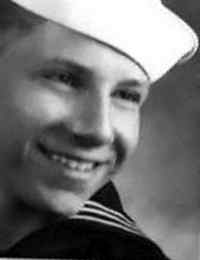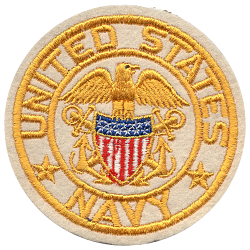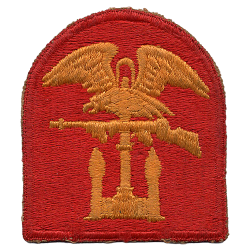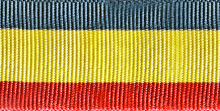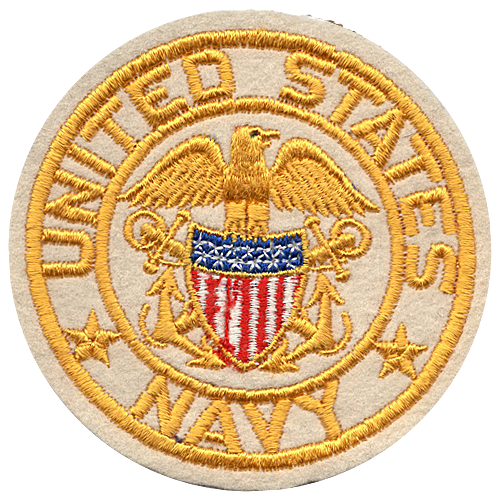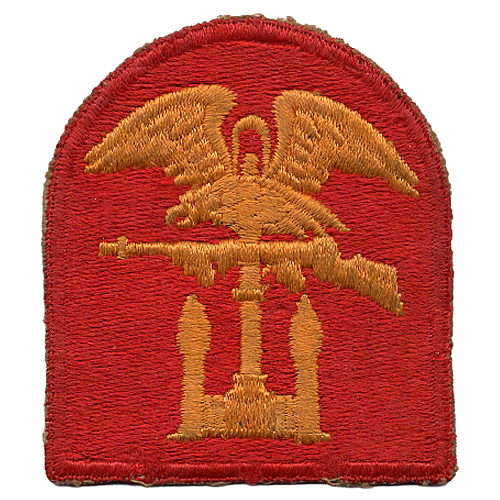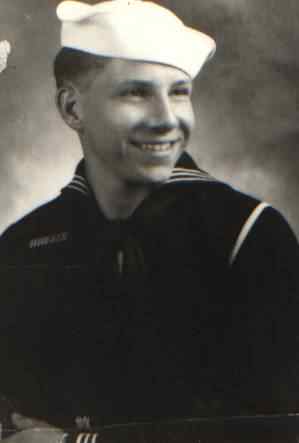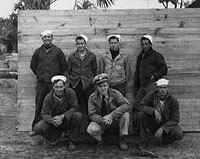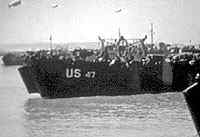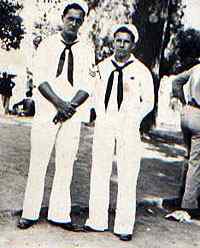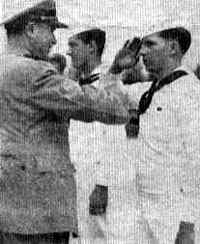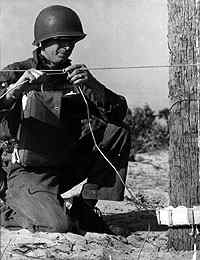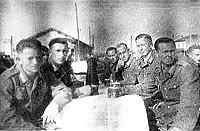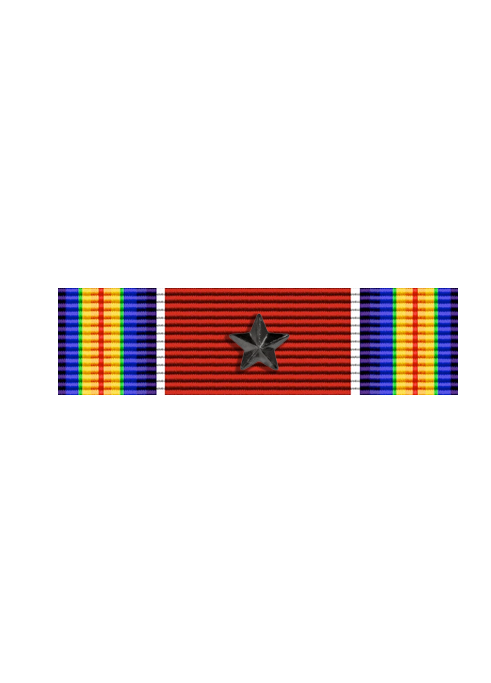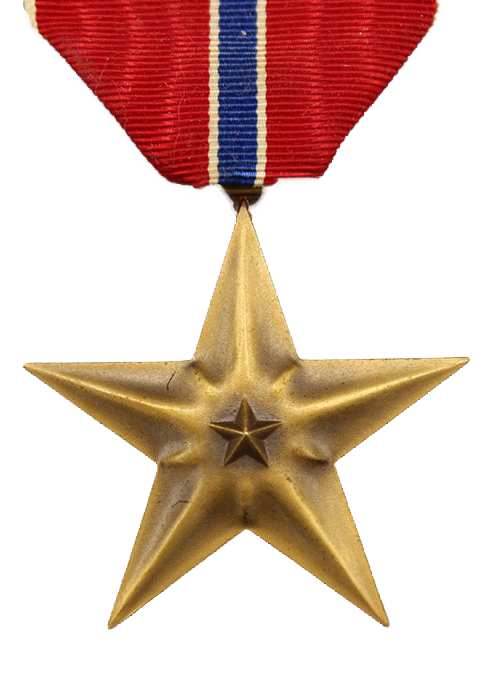The United States of America had been involved in World War Two for over two years when my father, a seventeen year old from East Hartford, Connecticut made his decision to volunteer for active duty. Lewis Dube enlisted in the Navy on February 9, 1944 (at 16 he passed his exams as a potential Army Air Corp aviation cadet, receiving his introductory flight from the Civil Air Patrol but found the travel prospects of Navy life more exotic in appearance.) Shortly after Naval basic training in Sampson, N.Y., Lew was shipped via Pier 72 in New York City across “the pond” to Scotland to begin explosives and assault training, eventually joining the members of NCDU (Naval Combat Demolition Unit) 127 which eventually became part of “Force U”.
Such began his preparation for the day in which he would participate, along with 156,000 troops from the US, UK and Canada, in the largest invasion force in history.
The NCDUs were developed from a growing desire for a force that could neutralize beach and underwater obstacles. In 1943 Admiral Ernest J. King expressed a need for these demolition units and petitioned for the Navy taking on this responsibility, especially in the Pacific Theatre. Although there is some dispute as to the development of the amphibious program, requests made by Rear Admiral Henry Kent Hewitt in 1943 for a special assembly of engineers and demolition experts coupled with the concurrent work of a Naval training facility specializing in demolition may have provided the impetus for the project. That training facility was at South Hutchinson Island, Ft. Pierce, Florida. Enlistment qualifications were that one could swim- and was preferably single. (For more detail I highly recommend Dunford and O’Dell’s book “More Than Scuttlebutt”, from which this last, highly researched bit was culled. See notes.)
The base at Ft. Pierce was crude by today’s standards; the buildings largely comprised of temporary plywood structures. Daily training was intense with a heavy emphasis pushing physical limits. Diving, rubber rafting and explosives became the staples of a day’s work. In addition to the taxing physical exercises, the tepid heat and sand flies diminished what sparce hospitality existed. “Young men only need apply.” Although it was an island, it was far from exotic.
At the beach it was a matter of getting the supplies ashore and taking cover for the moment
The task of each Demolition Party, which included not only the NCDUs but members of Engineer, Tank and Medical Battalions, was to destroy all above-water or submerged (it was planned that with landing at low tide they would all be above water) structures in a 50 yard section of beach at 250 yard intervals. This required careful timing; it was calculated that a 25 foot tide variance would occur that day- meaning that the water would rise about a foot every eight minutes. NCDU 127’s particular target was any obstacle in a 50 yard distance from a point 500 yards from the right flank. In order to accomplish this each man carried 35-50 pounds of explosives and detonating equipment (wire cutters, the infamous “Hell Box” detonators, friction tape, etc.). Descriptions vary somewhat but a demolition party might have consisted of one officer (the officer for NCDU 127 was Ensign Joseph Padgett,) 5 Navy demolition men, 3 Seamen, 5 Army Engineers, and 2 to 3 Navy sailors to assist the team as needed (such as for helping navigate the explosives laden rubber rafts which in many cases were abandoned as it was discovered quickly that they tended to draw enemy fire).
On the 6th of June, around 0300 or slightly earlier, the team disembarked from LST 47 and slid into an awaiting LCVP (landing craft, vehicle, personnel) which conveyed them into shallow water where the team then left their respective LCVP, waded into the cold Normandy surf in the dark, and began the slow drudgery of hauling heavy equipment and explosives through the low tide. As the demolition party worked towards the beach, German 88mm shelling of the approaching watercraft along with spray of machine gun fire created panic and an urgency to move quickly. This joined the din of the large scale coastal shelling of the Nazi defences by Allied battleships placed far back in the invasion traffic. One had to focus on getting to where they needed to be, staying away from anything flying, and to keep one’s body above the rapidly rising tide.
By H-hour+5 (0635 local) all were mobilised towards the beach, most NCDU personnel being unloaded into the water by H-hour+20. Awakened by the aerial bombardment and Naval shelling, the gradual German response became verbose and deadly. Carnage was immediate. NCDU 127 veteran John Dittmer remembers getting into the water; one of the first things noticed was a disembodied leg floating next to him. He held his nerve and pressed on (5). It was unknown to “Force U” at this point that they actually were about 1500′ south of the original proposed landing point. This proved to be a strategic advantage; there were less obstacles than originally expected and lighter German resistance due to earlier shelling which helped to minimize casualties- a contrast to what was occurring with their counterparts on Omaha Beach Because the German guns were close, they were forced to fire at angles to the beach and the landing areas proved to be more difficult targets for those guns not knocked out of service. But there was shelling and machine gun fire to contend with.
At the beach it was a matter of getting the supplies ashore and taking cover for the moment. Myron Walsh of NCDU 127 stated that he found the best method to advance on the beach was to go from shell crater to shell crater; “lightning never strikes twice in the same place". Once the team made it to the seawall they were able to send a small crew back for the explosives. During the brief lulls in the fire they began the task of packing the beach obstacles with Hagensen Packs, tying together the large lengths of Primacord, and signalling the oncoming troops with a purple smoke bomb that the area must be cleared for demolition. Finally they fired the “hell box”- the ignitor.
Care in placing the explosives on the obstacles themselves was key so as to avoid shrapnel from the exploding structures striking the team or anyone nearby. Because of the enormous amount of activity and confusion, the purple smoke signals were sometimes disregarded (or misunderstood,) and landing craft would move right into areas set for demolition. This greatly impeded some of the obstacle destruction. Regardless of the delays, very few misfires of explosives occurred- the effectiveness of the Hagensen packs was clearly proven, and by 0800 700+ yards of beachhead were open for traffic. In the areas open, gap markers were placed to signal safe passage. The green light was on.
The final stages of the landing were able to proceed as the demolition parties continued their work on destroying concrete, wood and metals structures that had impeded the advance of the landing craft. By 0930 Utah Beach was cleared of most obstacles; the team worked to locate and destroy unexploded ordinances (shells, mines, hand grenades, etc.) and to help move along the immense cavalcade of vehicles swarming the shoreline. What was left of the steel obstacles was later piled together by Army engineers who bulldozed them into large scrap piles. Some of this metal was reused later- welded to the front of tanks to assist in clearing brush and trees as the vehicles moved into densely vegetated areas inland.
The casualty rates overall on Utah Beach were lower than that of Omaha where the NCDUs suffered close to a staggering 50% figure (figures vary, but carnage was high overall.) Utah had its share of losses; 6 men from the NCDUs died during the fighting and 11 were seriously wounded. John Dunford of NCDU 127 was one of the wounded. The fatality count is in dispute with some arguing for even lower numbers.
The NCDUs remained on the beach for several days after the invasion assisting with unloading of equipment onto the beach and cleanup. Some of the lighter moments of the post-invasion period now happened such as the afternoon when one particular GI had dug himself a latrine only to find himself seconds later running along the beach with his pants down while being strafed by a rare Luftwaffe appearance (8). Fortunately, the only thing wounded in this episode was the poor man’s ego.
While encamped on the beach there was opportunity for some of the men to begin to comb about the area for souvenirs. On D-Day +1, Seaman Lew Dube and Petty Officer Gene Wirwahn were walking in the area of a couple of German “pillboxes”- a concrete and steel reinforced shelter designed as a machine gun emplacement and forward observation point. The two went back for help after seeing suspicious activity and gathered up Leland Prewitt and Jack Modesett for assistance. As the group approached one of the structures Lew peered into a small opening only to stare point blank into the eyes of a German soldier. A steel shutter clanged.
Quickly an Army officer was notified of the situation, but he balked at the idea that there were still any Germans left on ‘his” part of the beach. Prewitt made him a $5 bet that there were. A small armed party went over to deal with the situation. They first banged on the door, attempting to coax the Germans to surrender. Next a shot was fired down a ventilation hole, but to no avail. Finally the team blew open the door using explosives found in the adjacent remnants of another pillbox. Fifteen to eighteen German soldiers walked out, stunned by the explosion, and were prudently escorted to the POW cages set up on Utah beach area for an eventual trip to the UK. LST 47, the one that delivered NCDU 127 to the cold waters just hours before was now employed transporting POWs across the Channel after a stay in makeshift prison camps on the beach (7). Inside the pillbox, my father later stated, he saw about two weeks worth of food and wine, radio & telephone equipment. They were startled to discover an intact phone line to one of the deadly gun emplacements 100’s of yards away. It appears the Germans had settled in for the long haul and perhaps might have constituted a serious threat, spying from within what was believed to be a secured zone and forwarding intelligence to gunners abroad. CPO Prewitt became $5 richer that day. Wirwahn, Prewitt, & Modesett received the Bronze Star medal for this small drama, and Lew took away a souvenir German belt he found. He was inexplicably not included for the Bronze Star at this time, but this would eventually be made up for during Operation Dragoon. The episode was recounted back home the local paper; the East Hartford Gazette.
The NCDUs at Utah Beach were recipients of the Naval Unit Commendation for their actions of June 6th, and singularly so. Lew was sent back to England on 13 June 1944 and later boarded the USS Texas for a trip to North Africa (Oran.) From North Africa he was sent to Italy for preparations for the invasion of Southern France, Operation Dragoon, which occurred on 14-15 August 1944. He once told me that D-Day was relatively “easier” because it was all new and there was no time to reflect on it. In the Invasion of Southern France he carried with him the memories of Normandy and he was bloody terrified. “Task Force U” again was engaged.
Operation Dragoon is one of the under-rated campaigns of the World War. The landings occurred between Cannes and Hyeres and it began a landslide into France from which the Axis Forces never recovered. Like Normandy it involved a massive airdrop and a tremendous beach assault. Without it the progress of the Allies into France would have been immensely different. After many decades there is finally attention given to this invasion, but it will always be overshadowed by the awesome Normandy event of just two months previous. Just consider the logistics of these two huge invasions occurring within such a short time frame and with all of the political machinations of international forces! The preparation and moving of equipment was monumental. It was actually the second act of a controversial original plan opposed by many top Allied leadership to “pincer” the Axis. One can only speculate what might have happened had this opposition to the invasion held sway.
On 16 August Lew was back aboard the USS Texas, visiting North Africa and Italy- wrapping up his European travels in September 1944. From 28 September 1944 he was stationed at Ft. Pierce for the duration of the war where he worked in training and research for the NCDU program. By Fall of 1944, designated NCDU teams trained in what was called the “Maui Method”, which was the beginnings of the Underwater Demolition Teams- The UDTs.
Post VE-Day he remained in the US Naval Reserve until his honourable discharge in 1946, spending the last year of his service (with the rank of Storekeeper 3rd class) in Maryland following the closing of the training base at Fort Pierce.
Like so many of his generation he never spoke that much about the war. He would occasionally offer up some lighter stories like the time difference between an “88” shell explosion and the eventual report. The tale of a large wild boar they caught and roasted in a cut-in-half oil drum on the beach was fodder for Sunday family dinner conversations decades later. Then there was the unloading of his helmet and a souvenir German machine gun overboard in the Mediterranean. Or the trading of his M1-Carbine (made, not far from where I write, in Springfield, MA) for a rubber raft. Perhaps he thought of that as the start of his sailing adventures in peacetime? Anything else he kept to himself. He offered little. Most of his generation didn’t until it became clear the the stories might be forever lost. I didn’t know much about his story until I began researching some relatively new books and online declassified resources 10 years ago. Before his passing, he traded some stories with his comrades during the 50th anniversary of the campaign which saw a reunion of many of them in Florida. I wasn’t there to see that and am forever regretful. He visited Utah Beach and it was a moving experience for both him and our mother. A local newspaper wrote an article. Now we simply we miss his voice.
Our dad was content with the fact that he did his part, as was the nation’s mood of the moment, simply to fulfil what he saw as his own obligation in the overwhelming drama taking place, and then to move beyond it gently and quietly as a private citizen.
